In the sizzling hot heart of mid-summer, I launched an exciting new reoccurring post series here on Witchcrafted Life called Cemetery Journeys.
The inaugural post took an in-depth look at Kelowna Memorial Park Cemetery. It also delved the history of Kelowna itself, as well as that of cemeteries as a whole in Western Canada.
If you are unfamiliar with the history of non-First Nations burial grounds in this part of the world, I highly encourage you check out that post. The information it contains is applicable to many different cemeteries from around these Canadian parts and will continue to apply to most (if not all of) the various entries that this post series will house.
Despite the various challenges both of the ongoing pandemic and those that have been present in my own life throughout 2021, I am delighted to say that I’ve had a chance to visit a few different cemeteries this year (some, even, for the very first time 🥳).
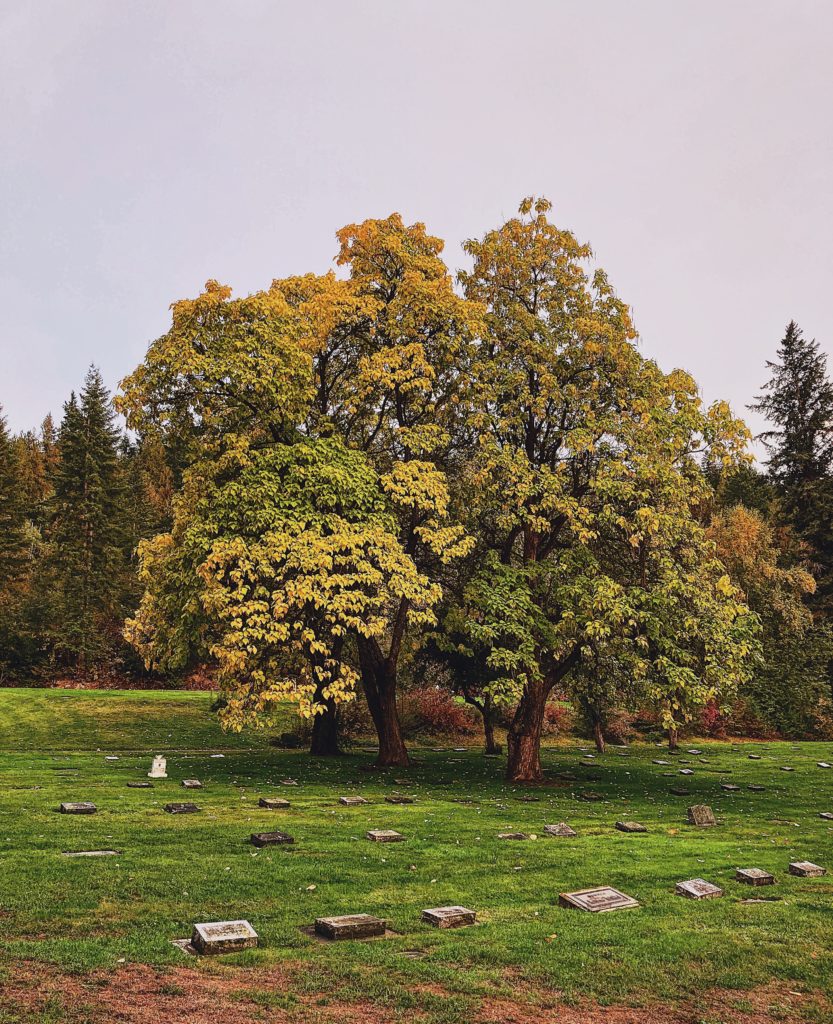
The respite, happiness, serenity, spiritual connections, education, and enjoyment alike that each visit brings my taphophilia adoring soul knows no bounds.
As Tony – bless his caring heart knows – there are few more effective ways to bolster my mood and help set my world right again (or at least temporarily suspend some of my worries and stresses) than time spent at a burial ground.
Knowing this, when I’m really struggling, worried, fighting extra hard on the physical or mental health front, or otherwise in need of a pick-me-up, he often drives me to various cemeteries throughout our region. The time that I spend at them never fails to help ground me and lift my spirits (pun mildly intended, sentiment no less sincere).
Naturally, I often visit cemeteries when things are not as rough as well. The same benefits still come my way in spades and are no less appreciated whether I’m on cloud nine, hovering above rock bottom, or anywhere in between.
It means the world to me that Tony understands how much visiting cemeteries means to me and the powerfully helpful impact that doing so can have on my health, well-being, and spirituality alike.
Awesomely, he also really enjoys spending time at and photographing burial grounds. Thus, our visits to such locations are frequently ones we savour side-by-side. Making the experience all the more enjoyable and memorable for both of us.
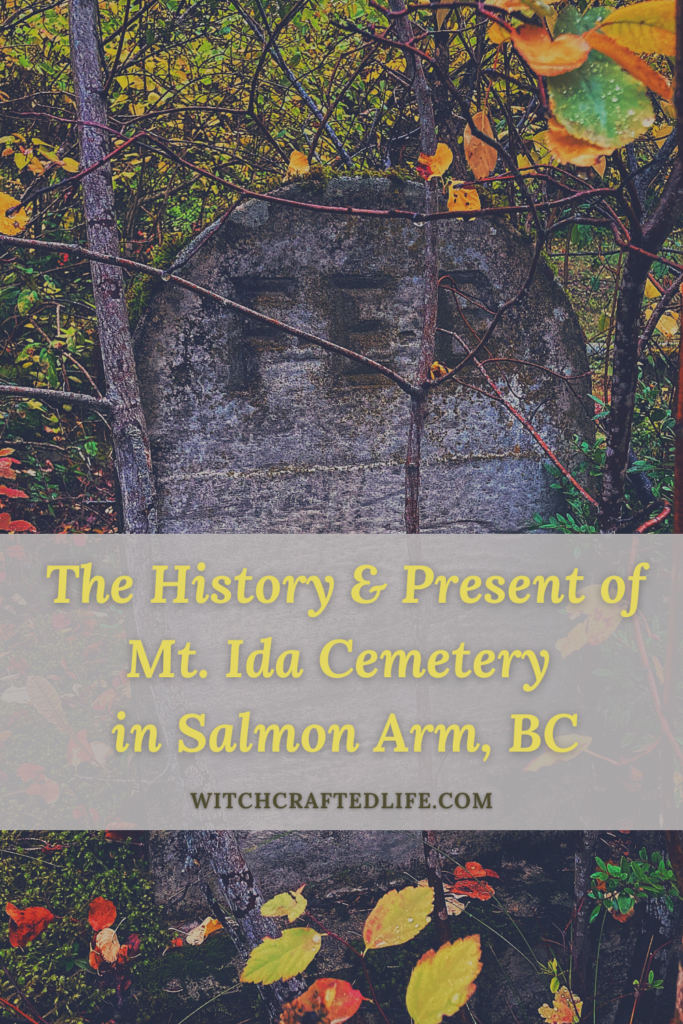
Our springtime jaunt to Kelowna took us an hour south of our wee town of Armstrong. In the second of our cemetery journeys, we’ll be heading about half an hour north to explore the serenely beautiful Mt. Ida Cemetery in Salmon Arm, British Columbia.
But first, let’s get to know this sun-kissed, Shuswap Lake-filled corner of BC – which has been a tourist hotspot for many decades now – a bit better.
A very brief history of Salmon Arm, British Columbia
To those unfamiliar with Salmon Arm, its name may, understandably, raise an eyebrow or two.
After all, salmon, like fish in general, do not have arms. 😄
Lest you think that some sort of Blinky-worthy salmon plies the waters of this province, let me assure you that the name Salmon Arm has nothing to do with appendages on fish.
Instead, it pertains to the fact that the large body of water called Shuswap Lake that Salmon Arm is located alongside has four “arms” (they are Shuswap Arm, Seymour Arm, Anstey Arm, and Salmon Arm, respectively). Each of which, historically, experienced large runs of salmon that used to fill the creeks that empty into Shuswap Lake.
This lake – one of the loveliest and most visited in the province – drains, via Little Shuswap River, into a smaller body of water called Little Shuswap Lake.
Fascinatingly, Little Shuswap Lake is the source of the South Thompson River, which is a branch of the Thompson River – itself a tributary of that lengthy, serpentine body of water that flows throughout a long swath of British Columbia, the majestic Fraser River.
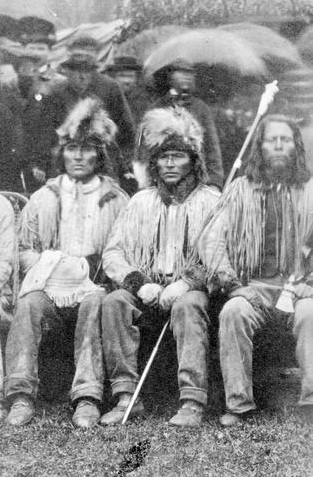
The word “Shuswap” stems from the Shuswap or Secwepemc First Nations People, who are the most northerly of the Interior Salish Peoples. In their own language, the Shuswap call themselves ʃǝxwépmǝx.
Salmon Arm is located in the Shuswap Regional District of the Southern Interior region of British Columbia. Though established as a town more than a century prior, it was not until 2005 that Salmon Arm officially became a city.
Do keep in mind, my dear readers, that the term “city” is used somewhat generously here throughout Canada. With a 2016 population of just over 17,700 inhabitants, Salmon Arm won’t exactly be vying on the population front with places such as Tokyo, New York, San Paulo, Cairo, or Moscow anytime soon.
Nevertheless, a city Salmon Arm is all the same and its modest population size only helps to add to the small-town charm of this gorgeous location.
In the 19th and early 20th centuries, British Columbia was awash with metal rushes, particularly those pertaining to silver and gold.
The importance of these events, the throngs of prospectors and other people they brought to British Columbia, and the towns that they helped to establish all contributed greatly to the present-day population and layout alike of this province.
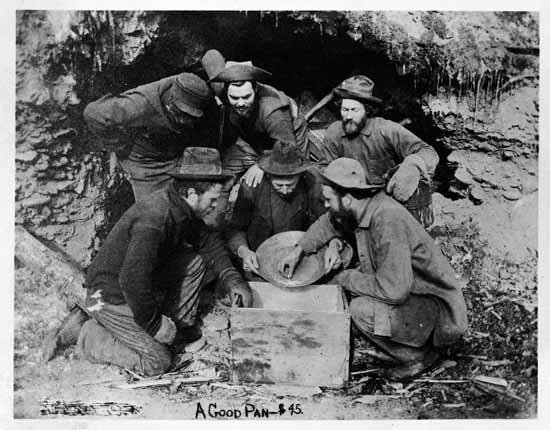
In the mid-1860s, the Big Bend Gold Rush along the hefty Columbia River saw an influx of prospectors traversing the interior of BC, some of whom journeyed through the Shuswap region.
The general area was noted by famed explorer David Thompson a few decades prior however, when in 1815 he recorded a lake called “Shuswap” in his travel writings.
The first non-indegious peoples exploration started in earnest throughout the area in the mid-19th century.
In 1880s, the Canadian Pacific Railway surveyed this corner of the province. In due course, track was laid and gradually settlement sprung up in the area throughout that decade and ever onward.
As one might imagine, the first corners of the Shuswap region that were settled housed the greatest potential as agricultural centres, as well as being both accessible and logical as routes in and out of the community.
The District Municipality of Salmon Arm was officially incorporated in 1905 and though it would, for a time during the mid-20th century be classified as a village again, it did not take long for the municipality status to return in 1970.
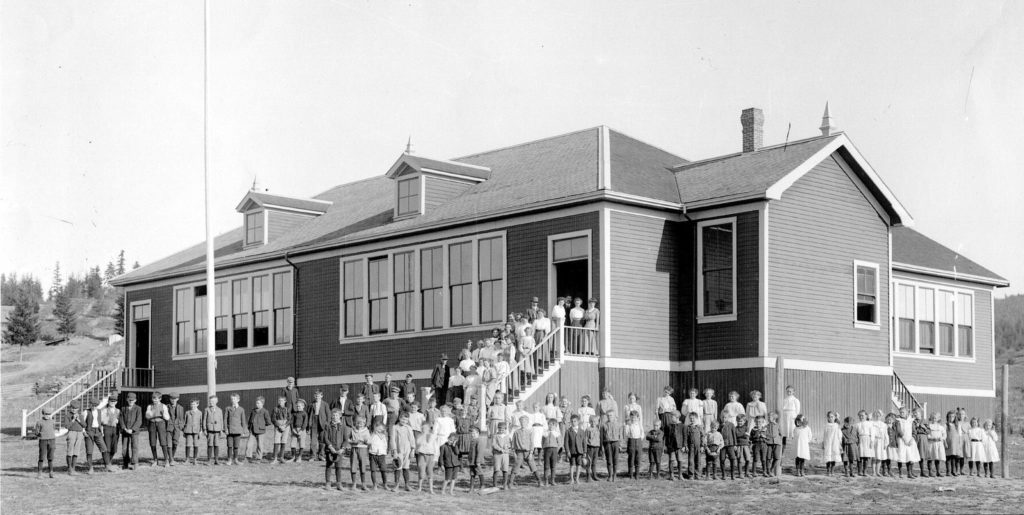
Throughout the first years of the 20th century, Salmon Arm established a well-deserved reputation as being an excellent producer of various types of fruit – particularly apples, pears, and plums.
This orchard industry helped the budding community to grow all the more and, in the process, made it a hub of both the immediate area and of this general region of the province as a whole.
No single individual or group was solely responsible for the creation and expansion of Salmon Arm and its smaller surrounding communities (such as Westwold, Coldstream, and Enderby).
Naturally, as with most communities, various early settlers left important marks on the area and some of their names are still familiar to many locals and those with an interest in BC’s history to this day.
Amongst this group of pioneers, settlers, prospectors, entrepreneurs and others one finds individuals such as overlander Alexander Leslie Fortune.
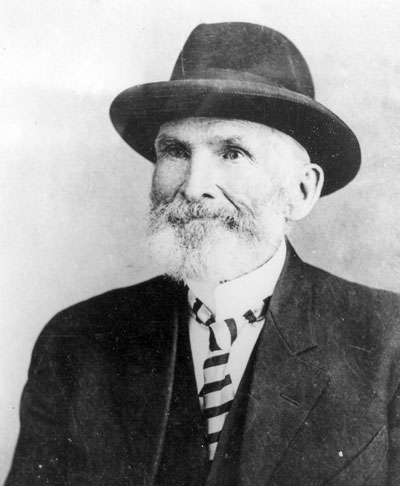
Mr. Fortune pre-empted some land that now sits slightly south of the present-day community of Enderby – which, at the time, was called Fortune’s Landing after Alexander himself.
Prior to coming west, Fortune married a woman named Bathia Ross and the two remained wed during the twelve – yes, you read that right, twelve – long years that he was out west and she was back east in Lancaster, Ontario.
Once reunited in person, the two lived in the North Okanagan-Shuswap area for decades, where they were well known for their kindness, hospitality, generosity, and civic-mindedness.
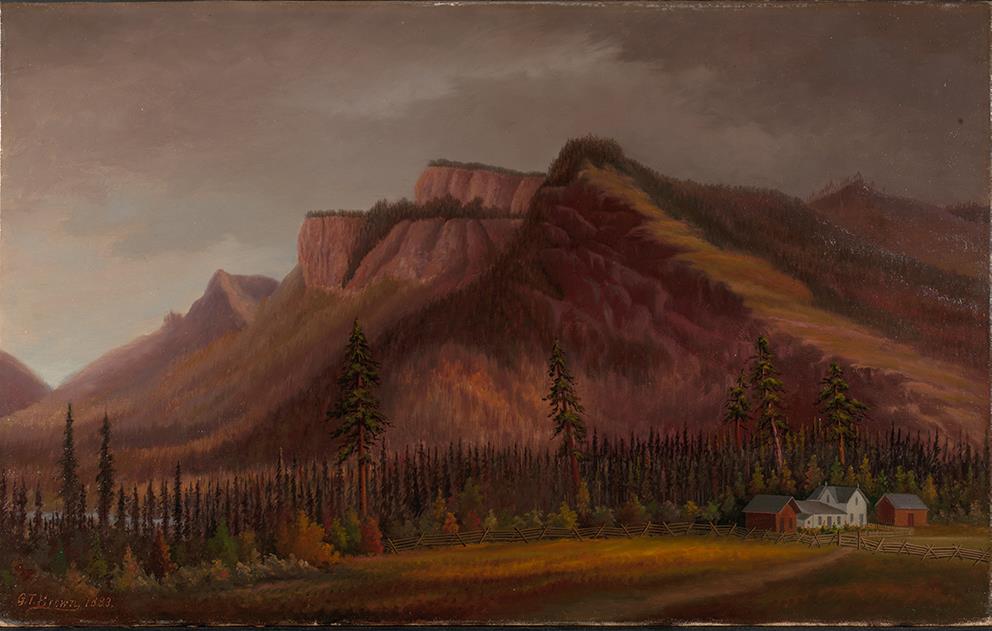
Their important contributions to the development of this part of the province and their surname alike continue to reverberate through various corners of the region, including in the name of Fortune Creek, which runs between Enderby and Armstrong.
In 1885, during the construction of the local railway (which was completed the following year), a brewery and gambling house called Dutch Charlie’s opened its doors. That same year, the first house in Salmon Arm was built by a German settler on what is today Beatty Street.
Dutch Charlie’s would be a relatively short-lived operation, however, with provincial police shutting it down in 1890 after an unsolved murder occurred on the premise.
In 1907, the first local newspaper – The Salmon Arm Observer – went into production. It remains in operation, including in digital form, to this day.
The Shuswap District (aka, Shuswap Region) sits immediately atop the Okanagan Region and to the East of the Thompson-Nicola District (in which one finds the city of Kamloops, which, with a population just shy of 100,000 inhabitants, is the province’s 12th largest municipality).
Much as with Okanagan Lake to the south, Shuswap Lake experienced a good deal of travel via boat, with the S.S. Marten (a Hudson’s Bay Company-operated steamer) being the first commercial boat to set sail on the sparkling waters of this lake.
This occurred back in 1866 and while Shuswap Lake have not been used as a primary means of transportation or commerce in the area for a number of decades now, it is still enjoyed by many pleasure crafters, swimmers, kayakers, paddleboarders, and others every year.
Salmon Arm has experienced continued population and industry expansion for many years now. As the largest community in the Shuswap region (and one that is situated on the majestic 89 kilometre/55 mile long Shuswap Lake), it is no surprise that tourists and those looking to relocate to the area flock to this picturesque corner of BC.
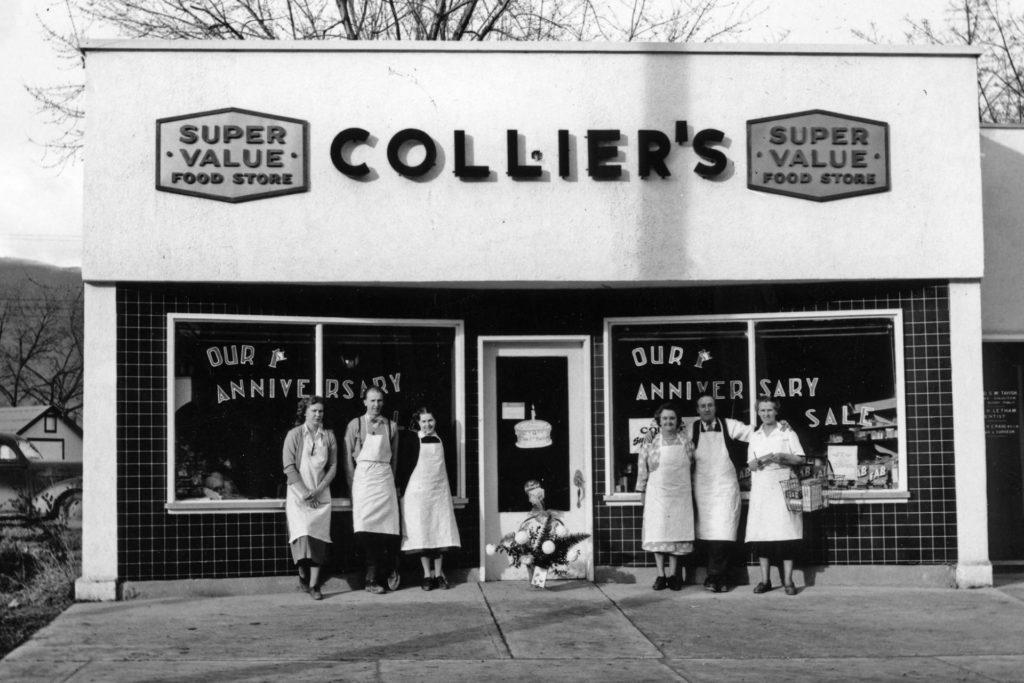
These days, Salmon Arm’s economy is guided by numerous sources, including tourism, lumber (sawmills have operated in the area since the late Victorian era), dairy farming, orchards, and manufacturing.
Visitors and residents alike enjoy the beaches, walking paths, and other amenities offered by Shuswap Lake, as well as the city’s museums (including the wonderful RJ Haney Heritage Park & Museum, which I’ve shared photos of over the years on my Instagram account), art gallery, local theatre group, assortment of both chain and independently operated shops, and the stunning outdoor scenery that surrounds and fills the town.
Salmon Arm is flanked by numerous lofty hills and mountains, and it is from one of the latter that the city’s primary burial ground, Mt. Ida Cemetery, takes its name.
Mt. Ida Cemetery in Salmon Arm
British Columbia’s cemeteries might not be the oldest in the world, but they must surely be amongst the most picturesque and peaceful.
A good many were built in areas that remain rich with breathtaking natural scenery to this day. Abundant trees, small hills, wildflowers and other natural charms often share space with gravestones whose dates span a century or more at this point.
This is precisely the case when it comes to Salmon Arm’s oldest and largest burial ground: Mt. Ida Cemetery.
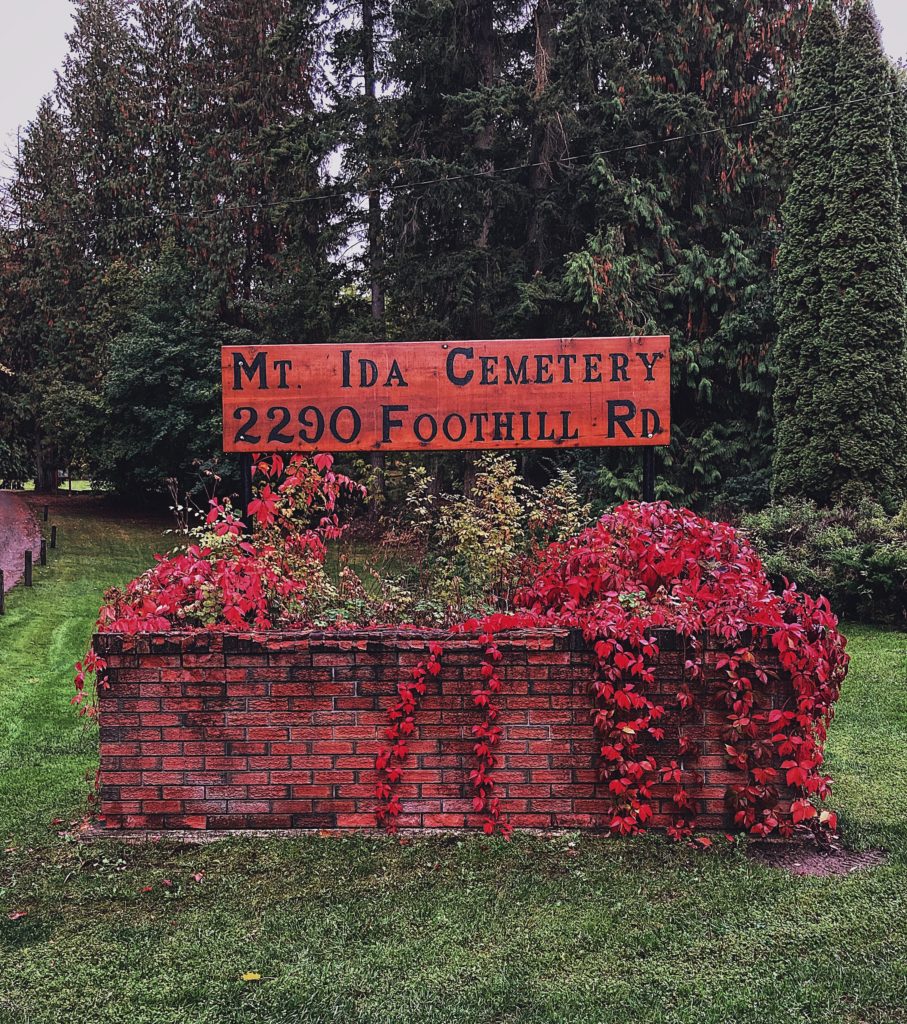
This idyllically pretty Shuswap District cemetery is located at 2290 Foothill Road SW, Salmon Arm, British Columbia.
It is open between 7 am and 8 pm daily, year-round.
Mt. Ida, the actual mountain, is believed to have been named in the 1870s (possibly by a Mr. J. Richardson) after Mount Ida on the island of Crete.
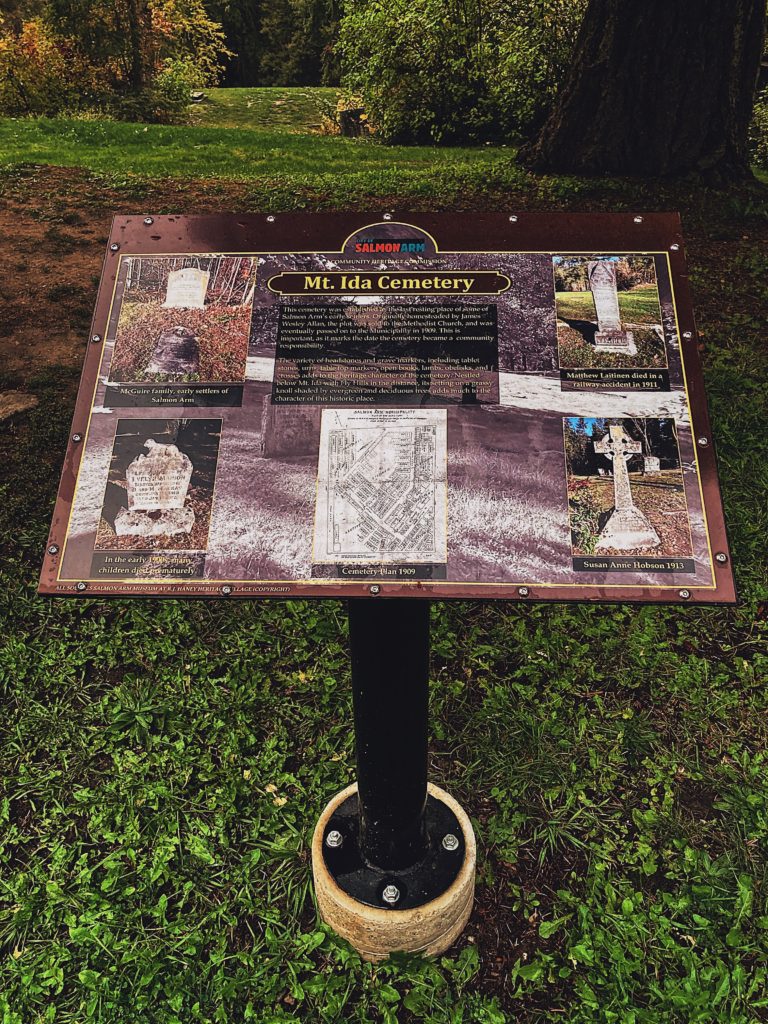
It should be noted that Mt. Ida in Salmon Arm, BC, is not related to the identically named Mt. Ida that is located in Kakwa Provincial Park, BC. The latter of which, at an impressive 3,192 metres tall and boasting a classic pyramidal shape, more than earns its nickname as the Matterhorn of the North.
In addition, it is important to remember that Mt. Ida is the name that the mountain in the Shuswap was given by white settlers. In the language of the local First Nations Peoples, this hill is known as Kela7scen, and it is considered a sacred site to indigenous communities of this area.
As a population began to be established in Salmon Arm and its smaller satellite communities, a cemetery naturally became a needed element of the township.
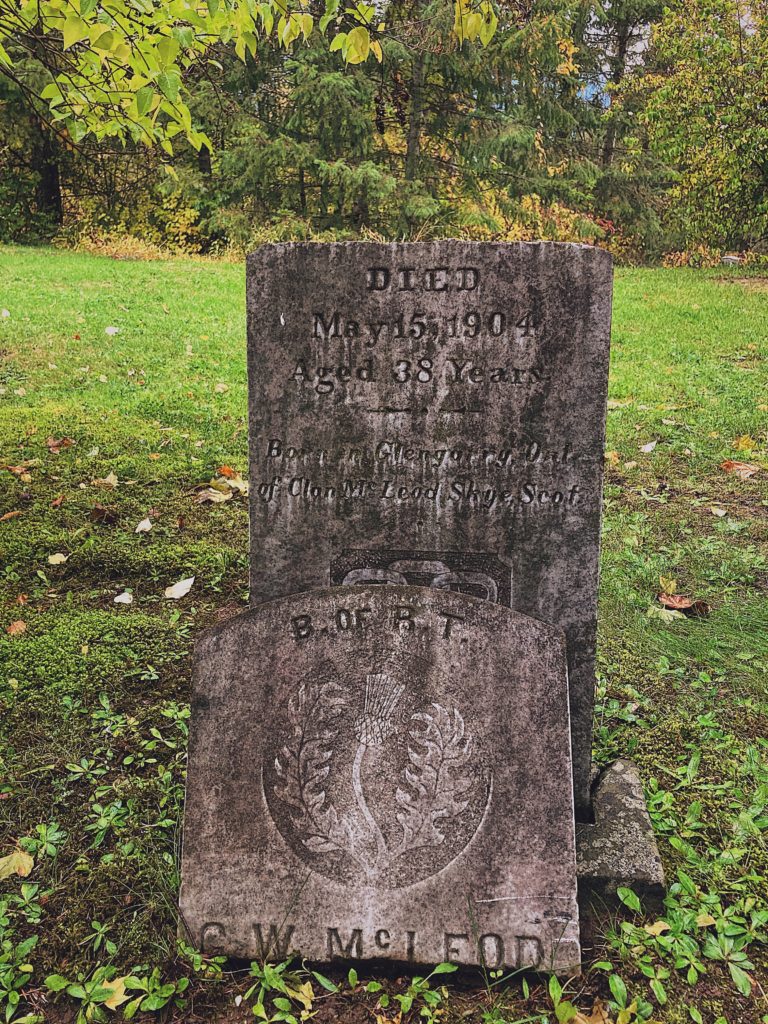
Once a suitable location was determined on the (then) outskirts of town, Mt. Ida Cemetery was opened and saw its first burial in 1894.
Two years after passing away from tuberculous at the age of just 26, Mr. Charles McGuire was reinterred at the Mt. Ida Cemetery. He was the son of Sarah Agnes and Alexander McGuire, two of the area’s earliest non-First Nations inhabitants.
After its closure as a public house, it was Charles McGuire who helped to turn Dutch Charlie’s into a locl trading post, all the while working to secure the burgeoning community’s mail contract.
The family’s name lives on in the area to this day via McGuire Lake and the adjacent McGuire Lake Park in Salmon Arm.
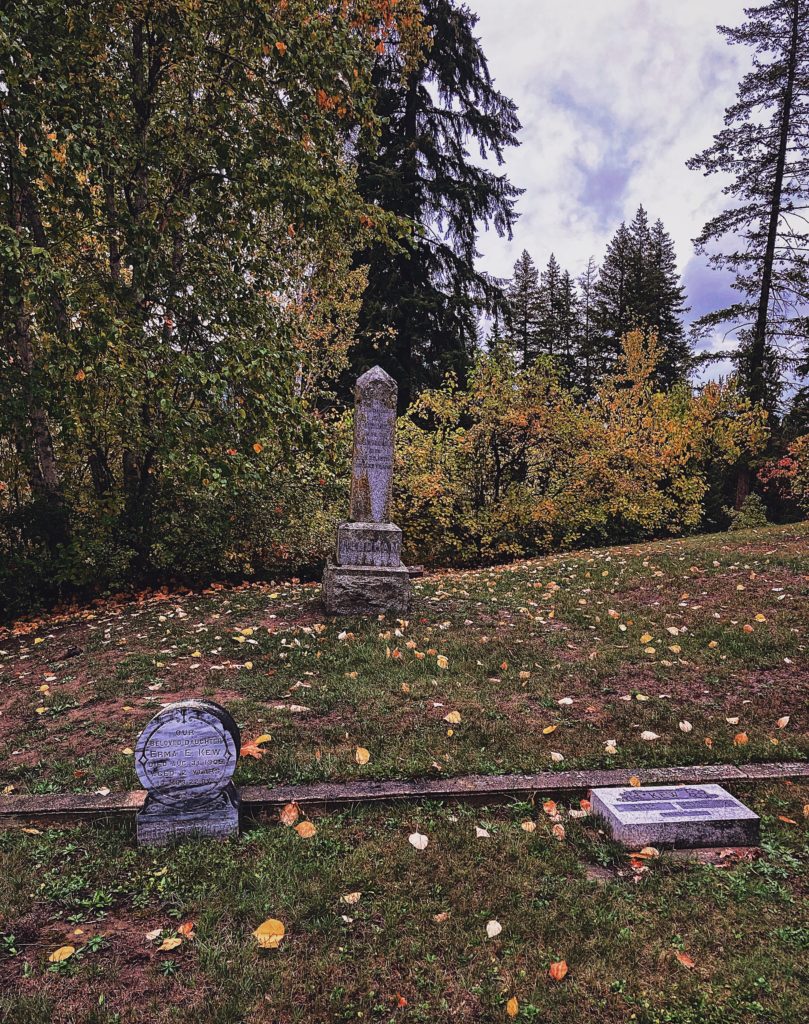
At the time of its opening, Mt. Ida Cemetery was a modest one acre of land that had been purchased by the local Methodist community with the (presumed) aim of it being a Methodist focused burial ground.
The Salmon Arm Reporter tells us that in 1909, ownership of Mt. Ida Cemetery was transferred to the municipality of Salmon Arm, under whose care it has remained ever since.
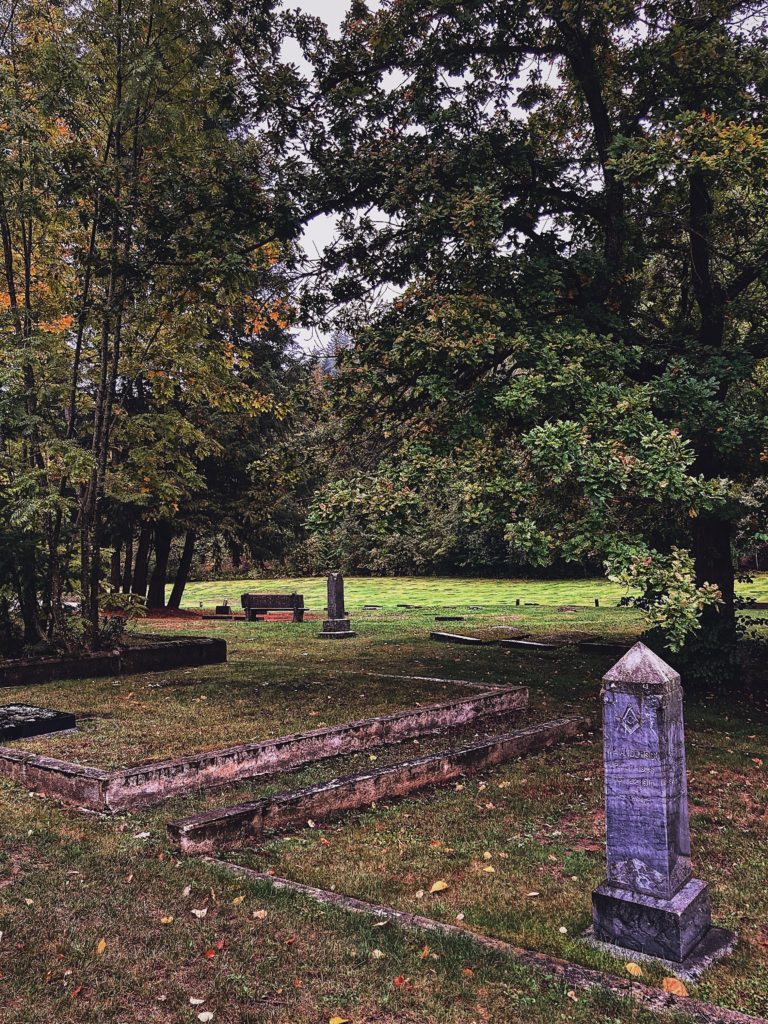
As one might expect, a fair number of the area’s first settlers and some of their descents have been laid to rest in Mt. Ida Cemetery over the years.
The earliest sections of the cemetery are now more than 125 years old and numerous headstones exist there which date from the 1890s, 1900s, 1910s, and 1920s. With continued burials from that point onward to the present day occuring throughout the grounds of this cemetery.
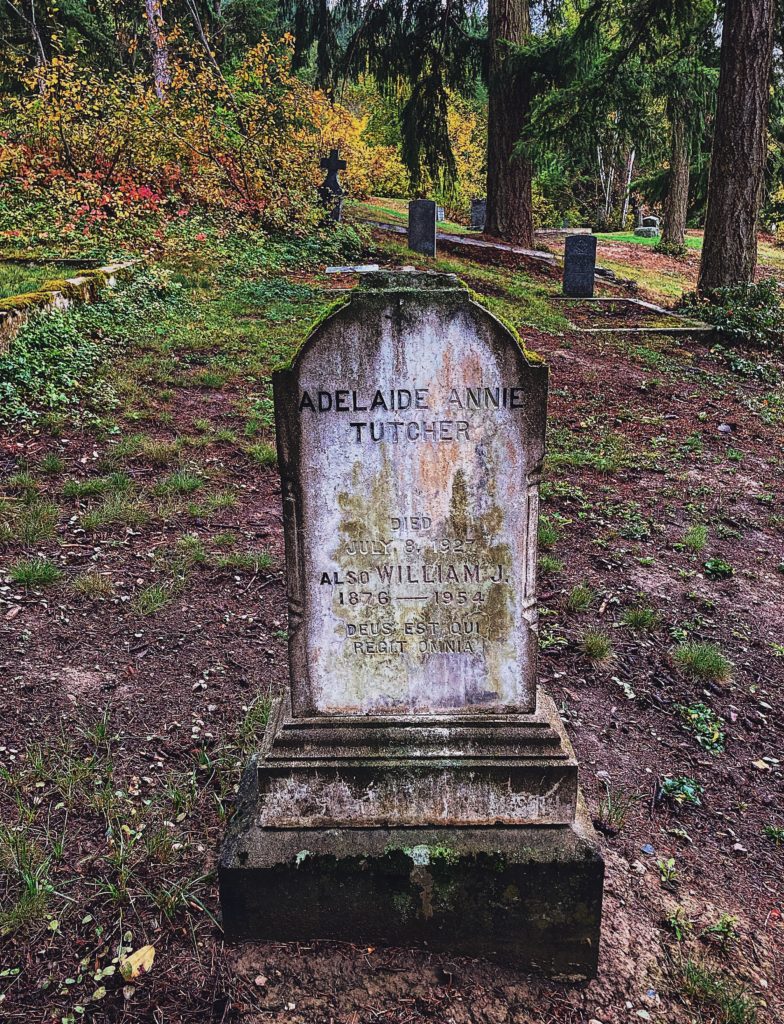
While the whole of Mt. Ida Cemetery is now considerably larger than its single acre beginnings, it is not so huge or challenging to traverse that one cannot explore the whole of it in a single outing – time, weather, and other circumstances permitting, of course.
The Old Section of the cemetery, as the original section is known by locals, includes a captivating array of grave markers and headstones.
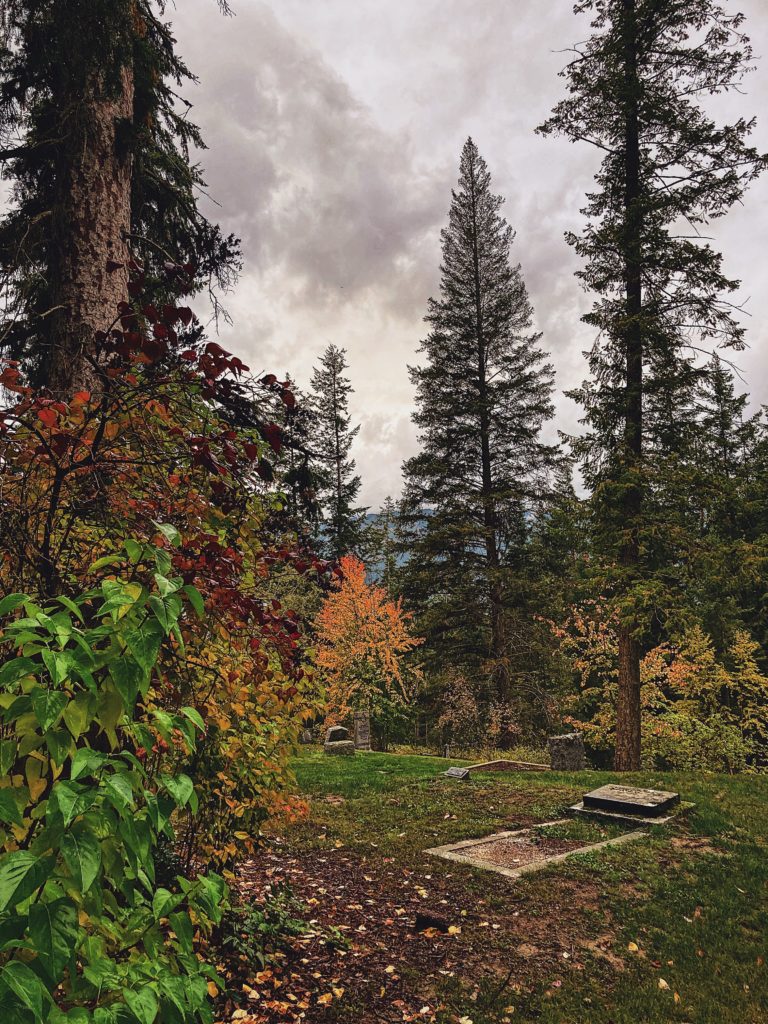
These include such styles as tabletop markers, tablet stones, set-ins, ledgers, obelisks, urns, open books, lambs and doves (typically used for those who passed away at a very young age), and numerous sizes and types of crosses, including Celtic crosses.
This portion of Mt. Ida Cemetery is located on a tranquil grass knoll that basks in the refreshing shade and beauty of numerous maple trees, all of which reside at the foothills, so to speak, of Mt. Ida itself.
In addition to those of Northern and Central European ancestry, amongst Mt. Ida’s earliest residents, one finds members of the Chinese Canadian community as well. Later interments include those from many different parts of the world and numerous grave markers appear in languages other than English.
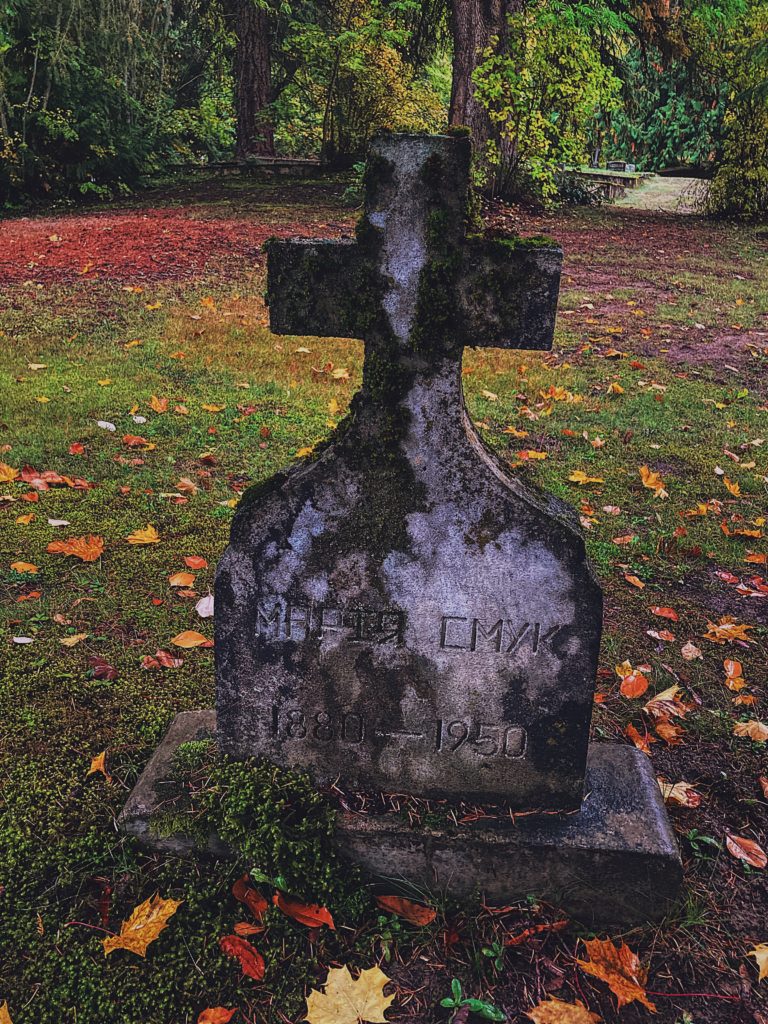
Mt. Ida Cemetery is maintained by the city of Salmon Arm and like many Canadian burial grounds, includes a section specifically for members of the Canadian Armed Forces.
In addition, a touchingly lovely memorial cairn has been placed to the right of this section of the cemetery with small plaques bearing the names of fifty local veterans.
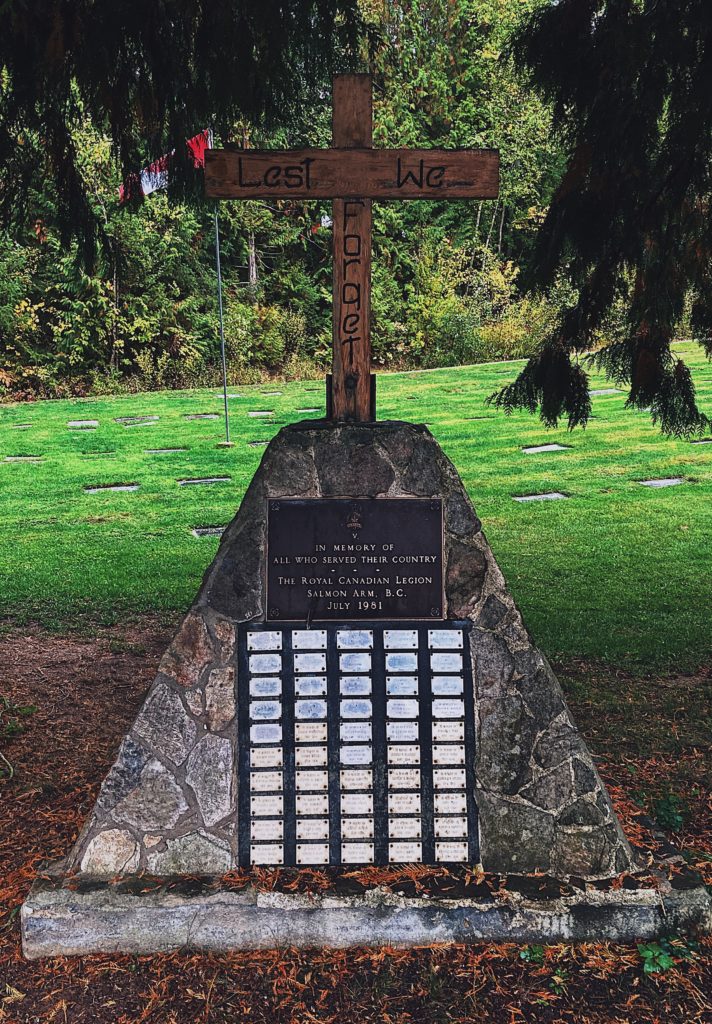
According to the Findagrave.com entry from Mt. Ida Cemetery, as of the time this post is being written (in November 2021), there are approximately 5,302 memorials on the premise. A space that sprawls across about 110 acres, only nine of which have been deemed suitable for internment usage.
Annually, about 75 to 80 new individuals are being housed at Mt. Ida Cemetery.
In addition to in-ground burials, the city of Salmon Arm recently put installed a new 24-unit columbarium for cremation internments.
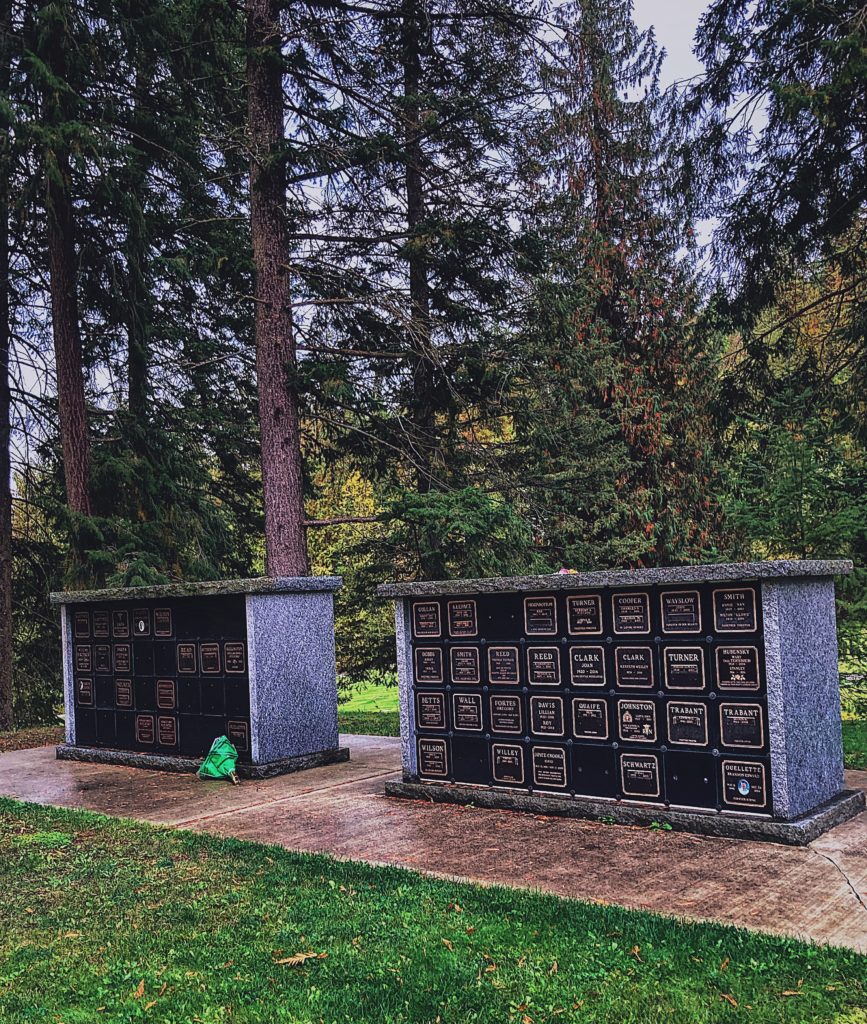
Interestingly, as Mt. Ida Cemetery is now nearing the maximum number of burials that are permitted in the suitable ground that is available, the city has obtained a new piece of land and is developing the Shuswap Memorial Cemetery on it.
This newly constructed 25-acre cemetery is located at the southeast end of Salmon Arm at 2700 20th Avenue SE. It provides grave plots, scattering gardens, family vessels, and columbariums.
A peaceful early autumn visit to Mt. Ida Cemetery
In the first days of this fall, Tony and I decided to take a late afternoon drive up to Salmon Arm.
More than a year had passed since we had last stopped in to visit Mt. Ida Cemetery while in Salmon Arm and the start of what is both of our favourite season seemed like an ideal time to do so again.
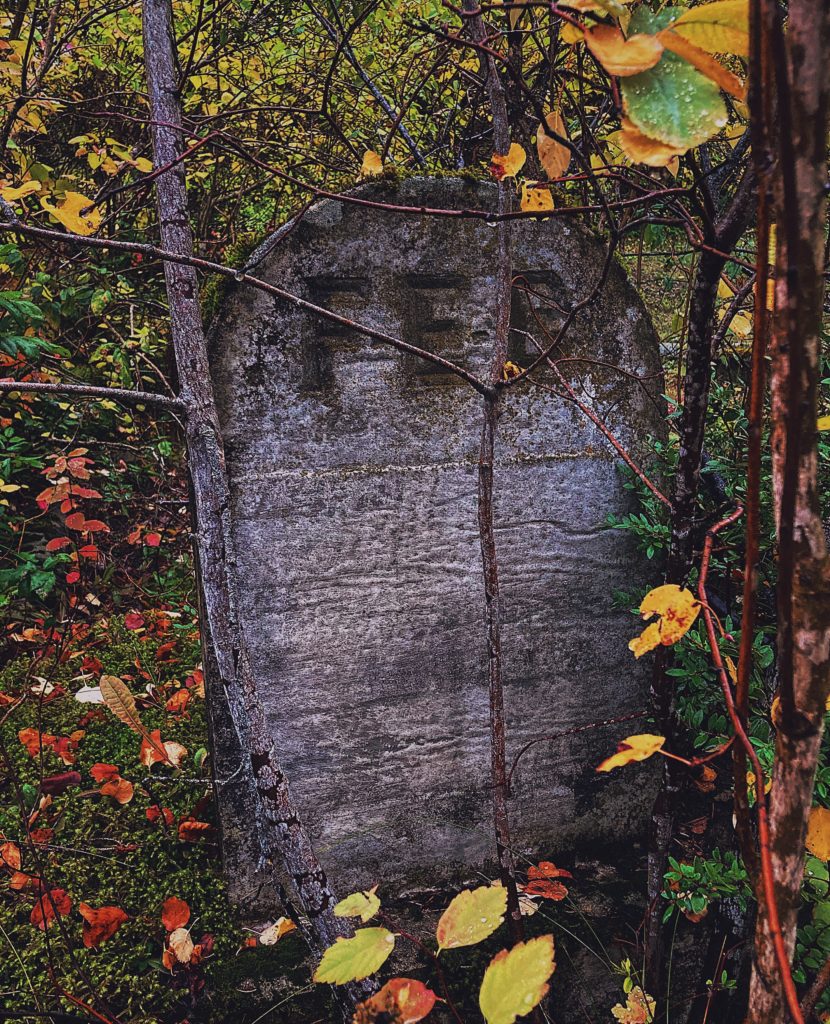
While I have photographed parts of Mt. Ida Cemetery on previous visits, I’ve not yet shared many (if any) of those images publicly (though hope to do so as time goes on).
All of the images of Mt. Ida Cemetery housed in this blog post were taken by me with my iPhone in September 2021.
The day we were there was chillier than one might expect for the very start of autumn and rain had fallen prior to our arrival at the cemetery.
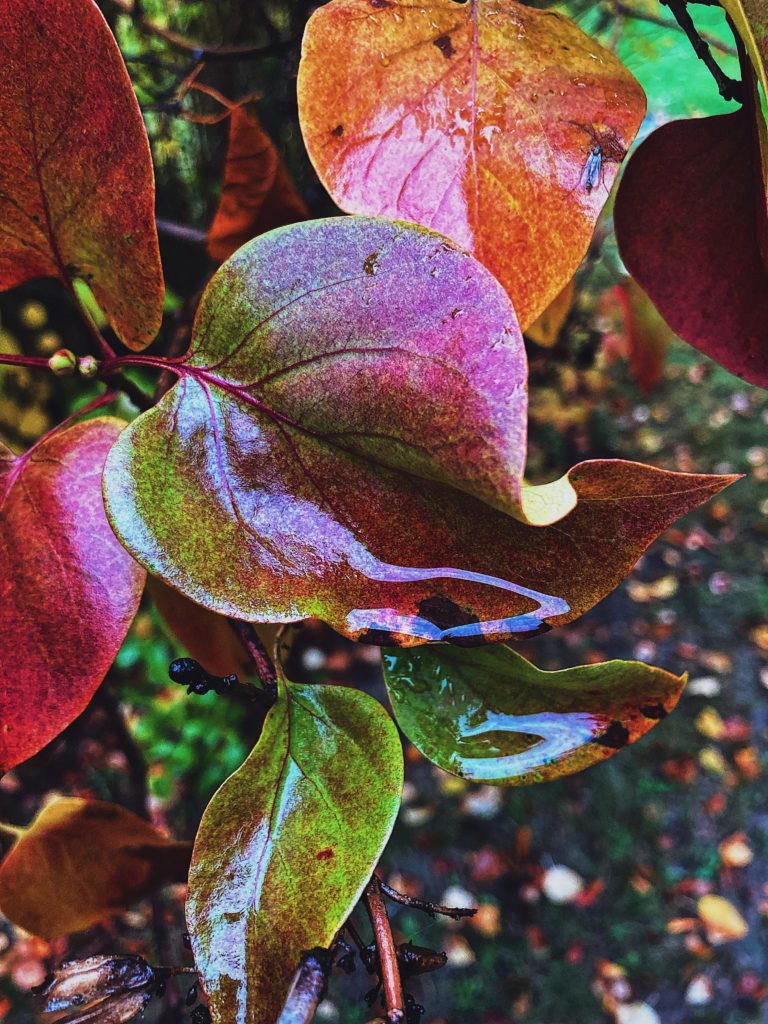
A few brief spits tumbled down while we were there, too, but not enough to send us fleeing for the car.
The sky overhead summersaulted between hues and intensity of light. One moment it was a mix of dusty periwinkle and aged sand, the next glisteningly blue, and the next still as grey as the antique headstones that dot the property itself.
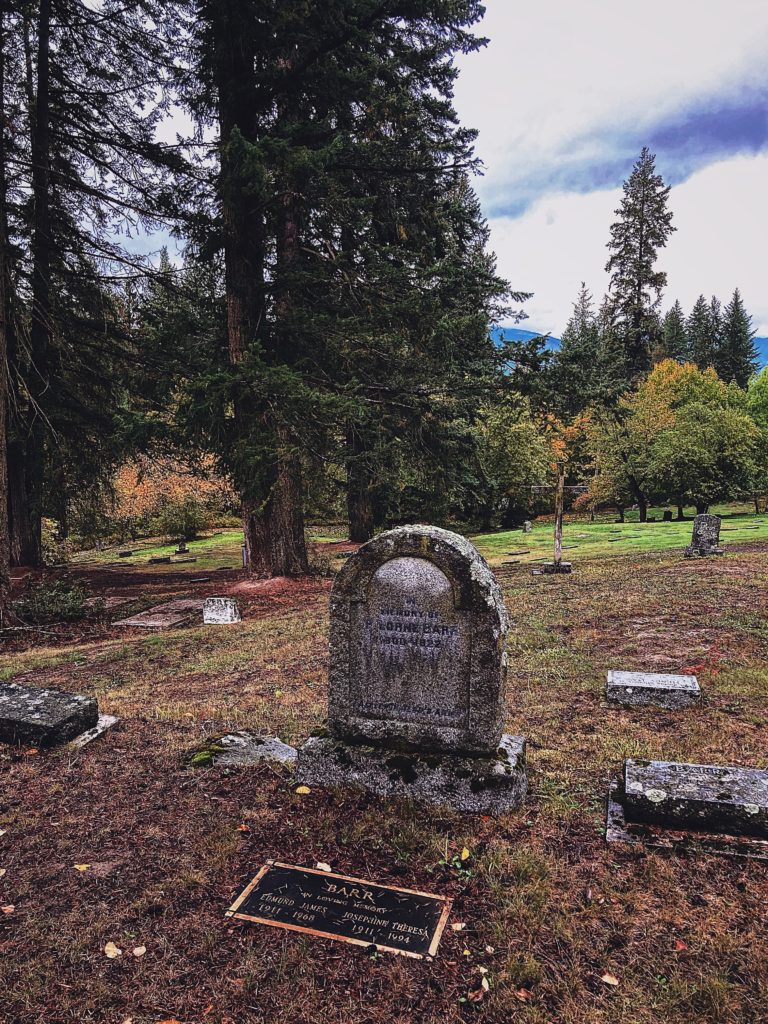
All around us, the many trees, shrubs, and other greenery of Mt. Ida Cemetery were embracing the current season and glowing resplendently in their early fall colours.
Much of the earth and bark mulch at Mt. Ida has a warm, naturally reddish-brown colour to it which was brought to the fore all the more by the damp conditions and accompanying fall foliage.
I will happily visit a cemetery at any point in the year, but especially welcome the opportunity to do so during the autumn months.
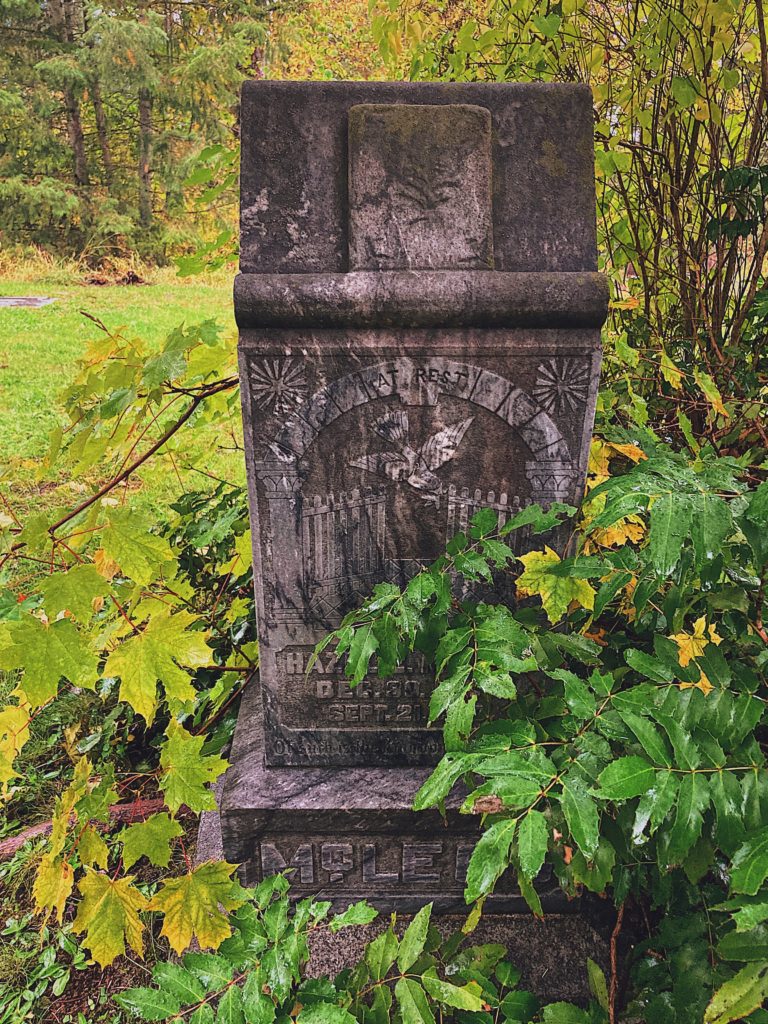
Not only does the local landscape stand to be awe-inspiringly gorgeous, but the powerful connection between the departed and the weeks that span the Pagan sabbats of Mabon and Samhain provide an even greater spiritual connection, as the veil thins to its most gossamer point in the year.
On this visit, knowing that I would be blogging about the history of Mt. Ida Cemetery, I was keen to cover as much ground there as I realistically could before the day’s light gave up the ghost.
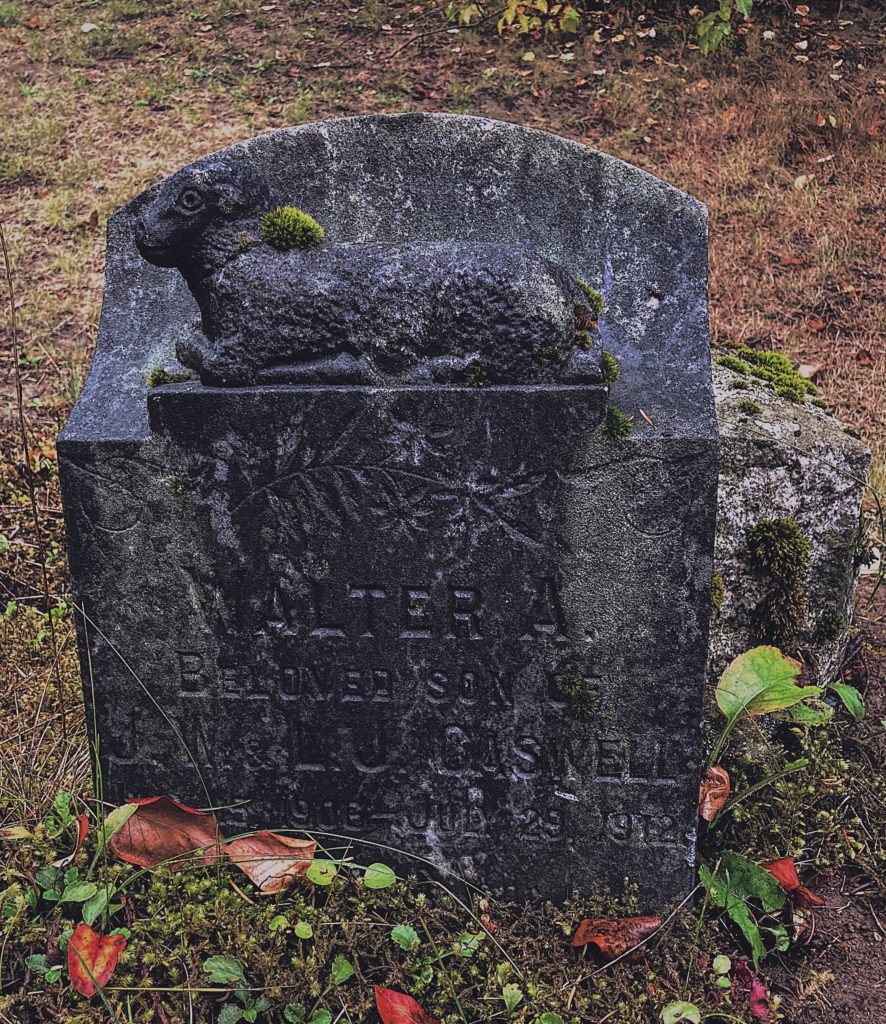
While, interestingly, I did not spy Charles McGuire’s headstone (I will be keeping an eye out for it on future visits), I did have the pleasure of documenting many other early grave markers belonging to some of the area’s first settlers.
When visiting a cemetery, my interest and focus generally lies with pre-circa 1960s inhabitents. However, I make a point of exploring as much of a given burial ground as I possibly can. And, in the process, reflecting on and paying my respects to both the more recently departed and those who have been laid to rest for a good many years now.
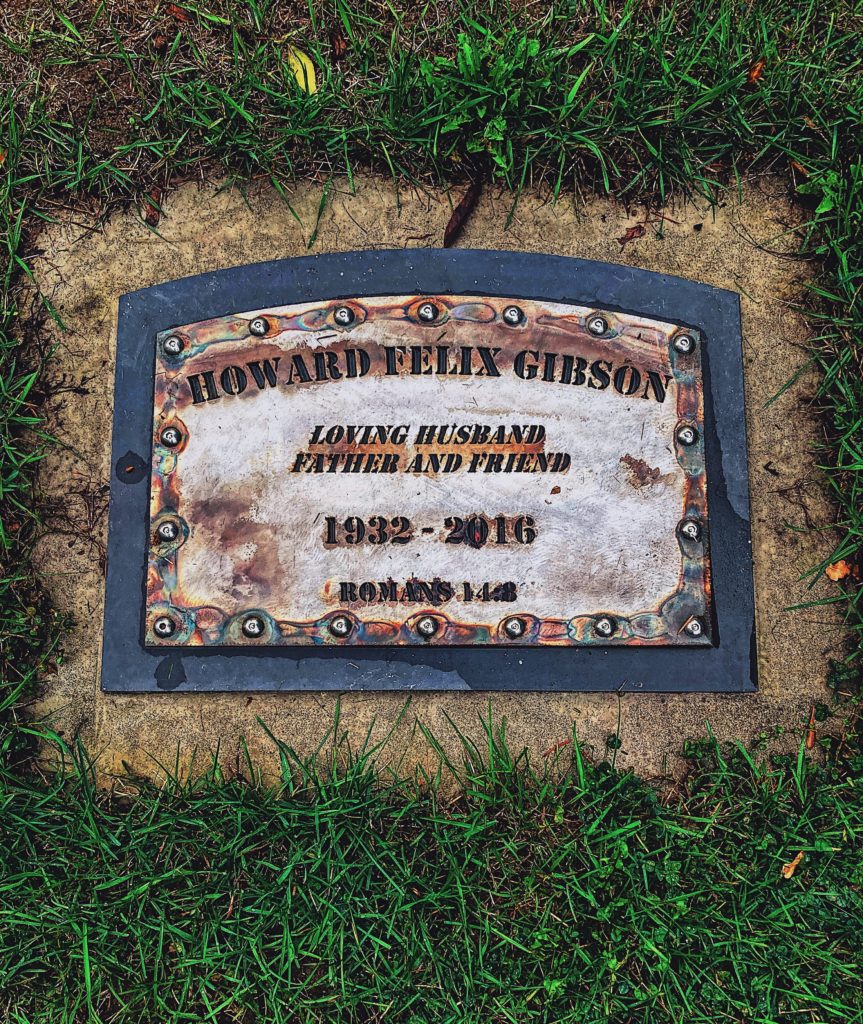
If you are planning a visit to Mt. Ida Cemetery in Salmon Arm, BC, and wish to explore it thoroughly, I would suggest allotting anywhere from 2 to 4+ hours to do so.
Having been there before, I had a lay of the land already (including knowing where the Old Section is located) and that helped to save time.
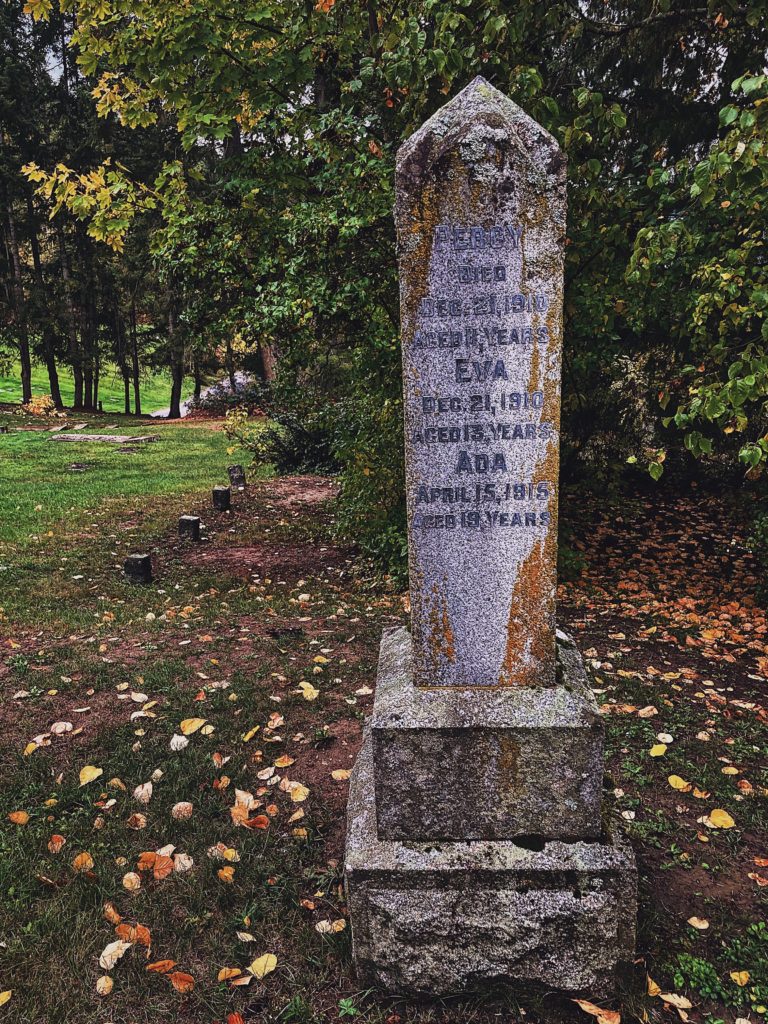
There are no washrooms on premise (objectively, few cemeteries I have ever been to included public washrooms), however, there are a small number of benches around the property if you wish or need to stop and get off your feet for a while.
The terraian is a mix of unpaved and paved paths, as well as ample grass and bare soil covered ground.
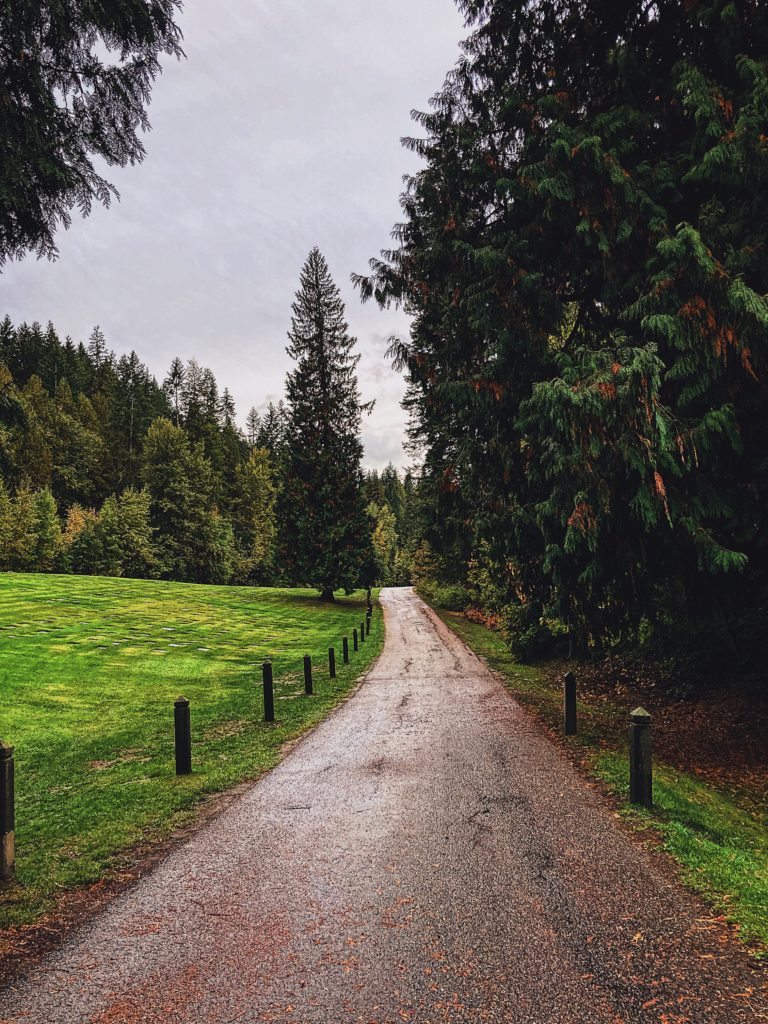
If you visit from about May to mid-September (or later still if it is an especially warm autumn), please note that the mosquitoes on the property can be brutally thick.
A previous summertime visit saw me inundated by more mosquitoes than at almost any other time and place in my entire life.
All that to say, if you pop by Mt. Ida during the warmer months, use bug spray and wear clothing that covers as much of your body as possible.
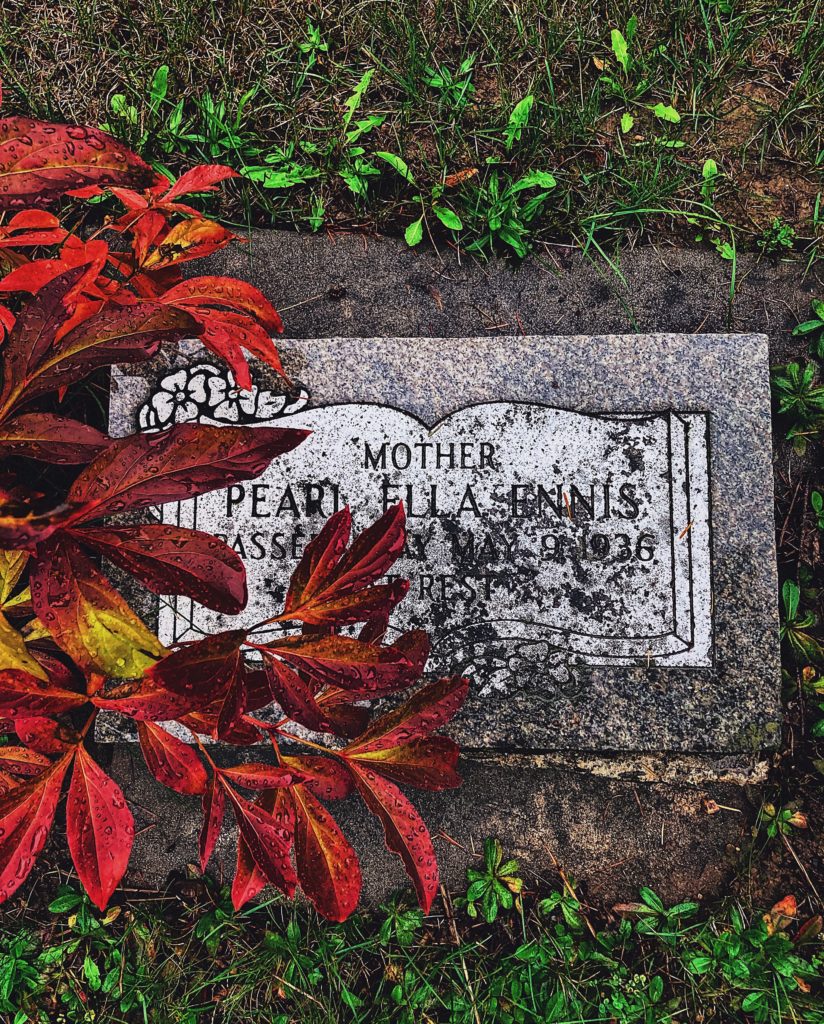
Much to our delight and relief, nary a single mosquito was spotted while we were there at the start of this autumn.
As well, once the snowy season returns it becomes trickier to traverse the whole of the cemetery on foot unless one is sporting suitable wintertime footwear, such as snow boots or even snowshoes.
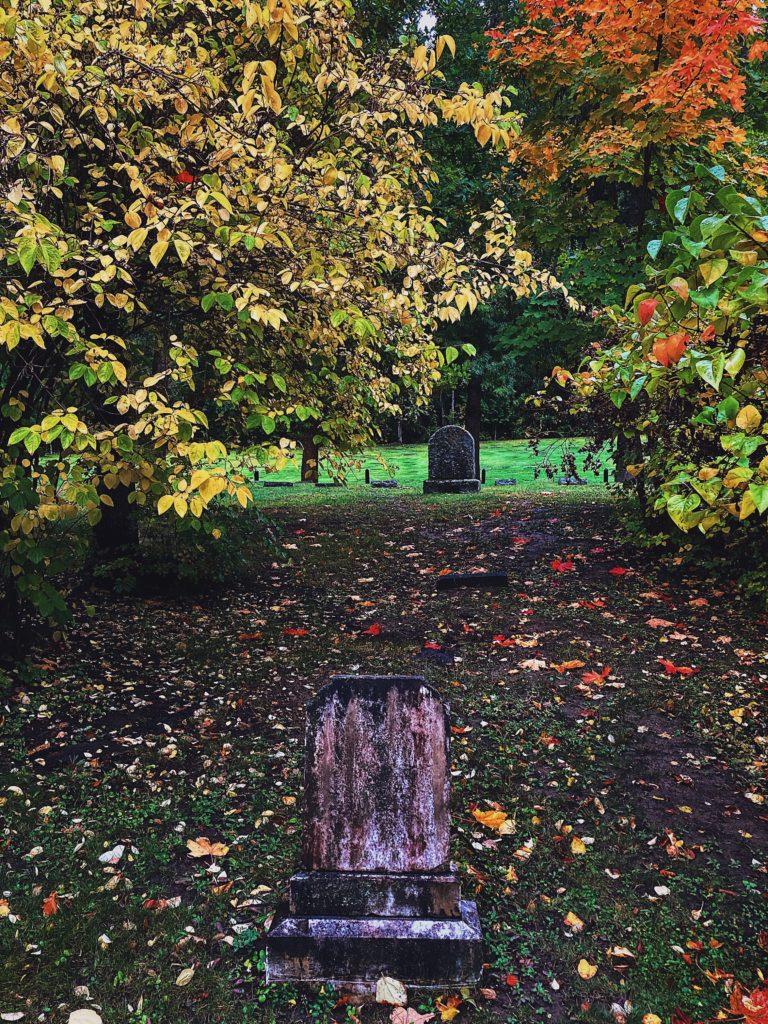
However, that said, the paved and unpaved pathways (some of which cars are permitted to drive on) should be a bit easier to tackle even in the snow.
Given its relatively close proximity to our house, the fairly large number of interments, and the rich history that this burial ground contains, it is safe to say that will continue to visit Mt. Ida Cemetery from time to time.
Especially during the fall months, when this historic Shuswap District cemetery presents a celebration of both departed human lives and the last days of the year’s mesmerizing foliage.
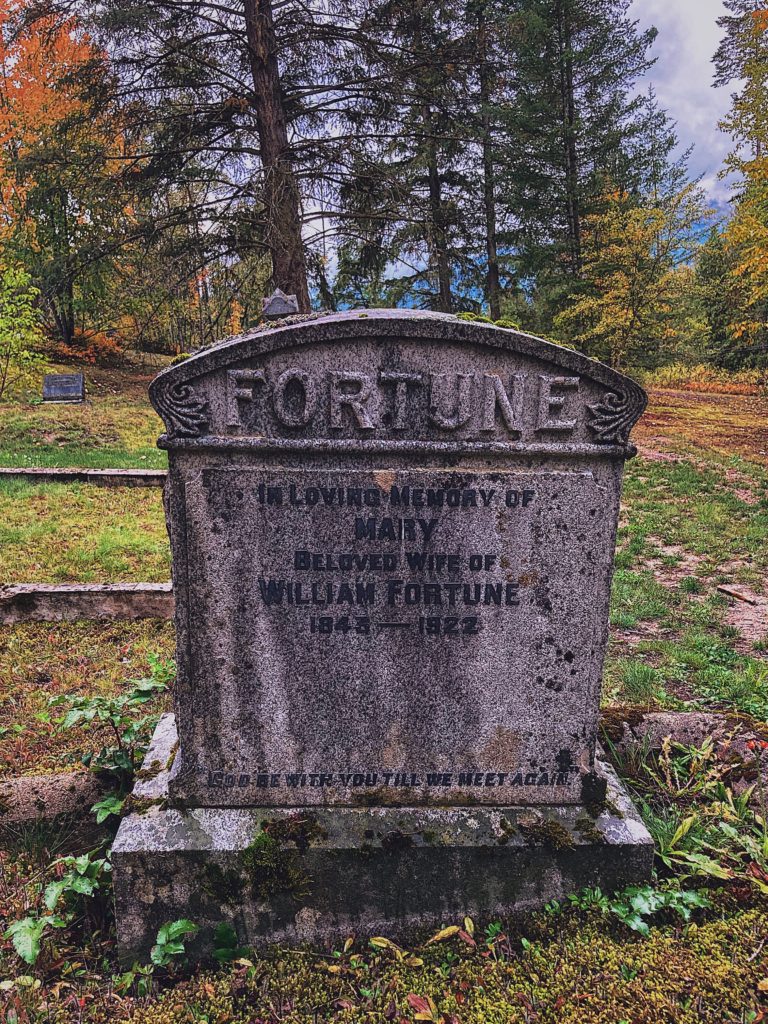
Have you ever visited Salmon Arm’s Mt. Ida Cemetery? Which of the grave markers featured in this post sparked your interest the most? 🍂🤎🍂
Explore additional burial grounds that have been visited in the Cemetery Journeys post series:
–Kelowna Memorial Park Cemetery, Kelowna, British Columbia
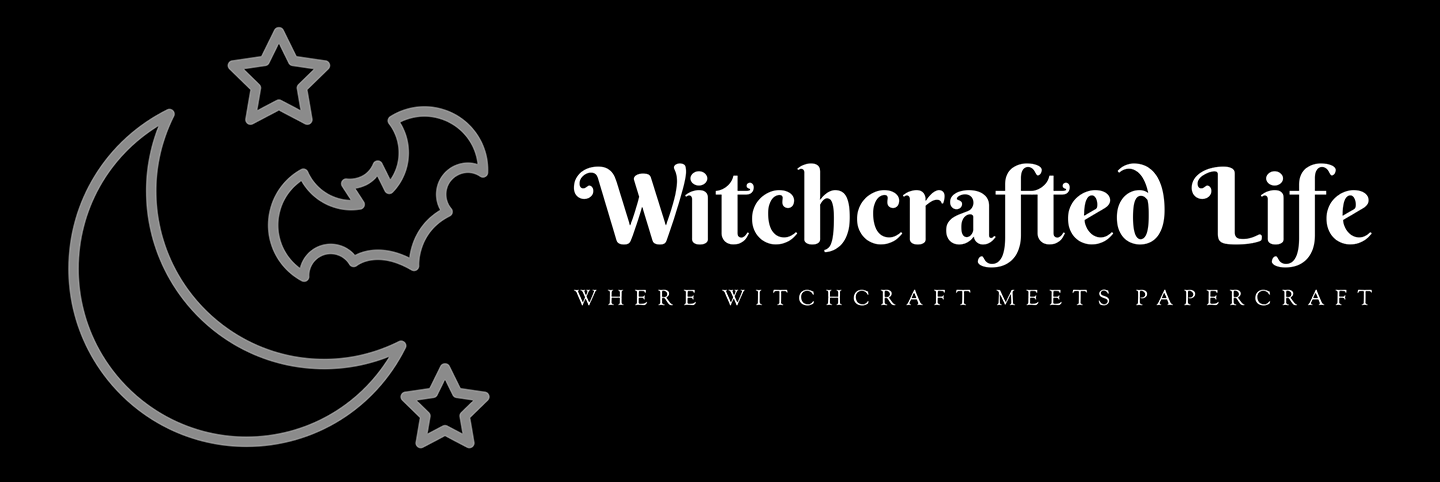
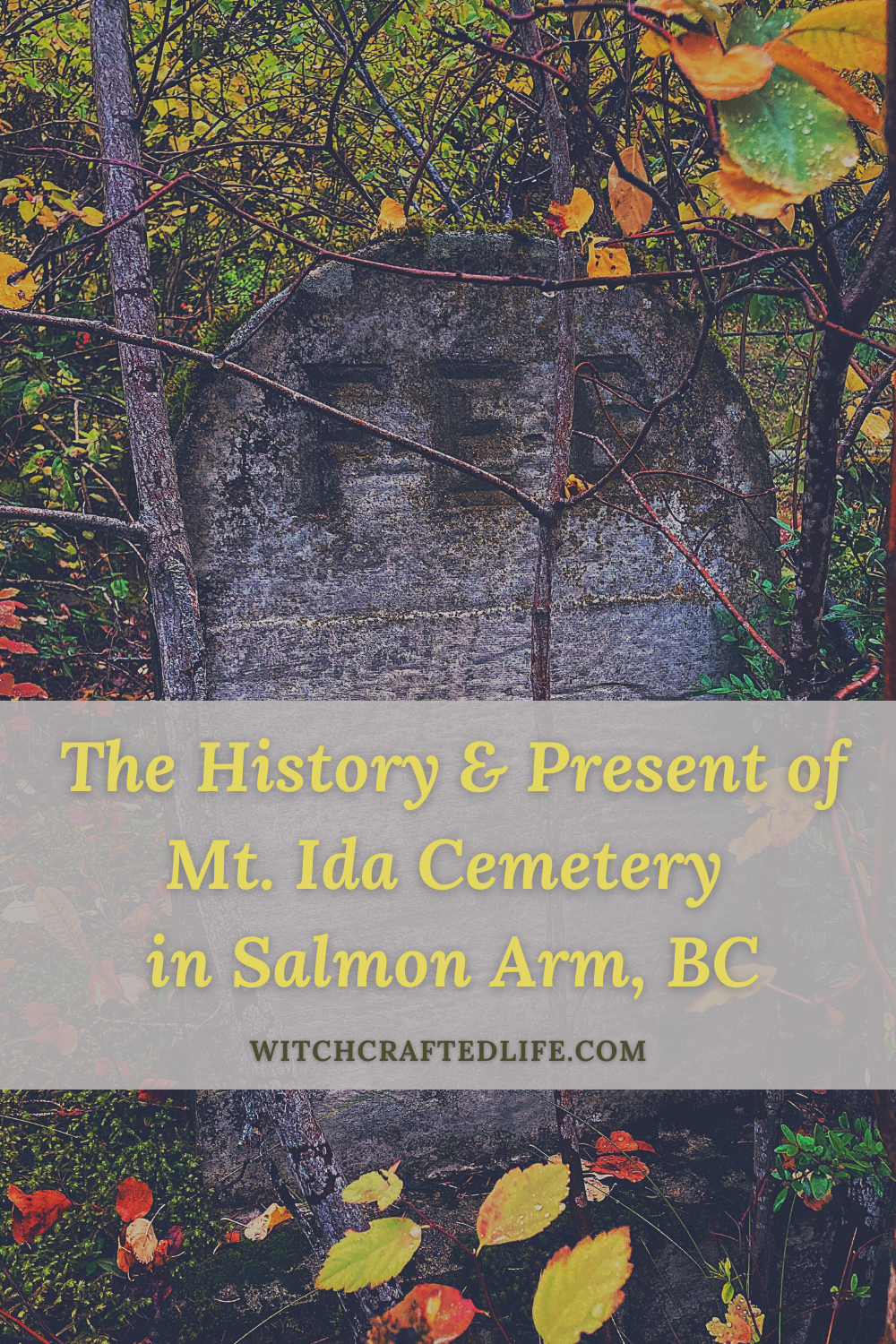
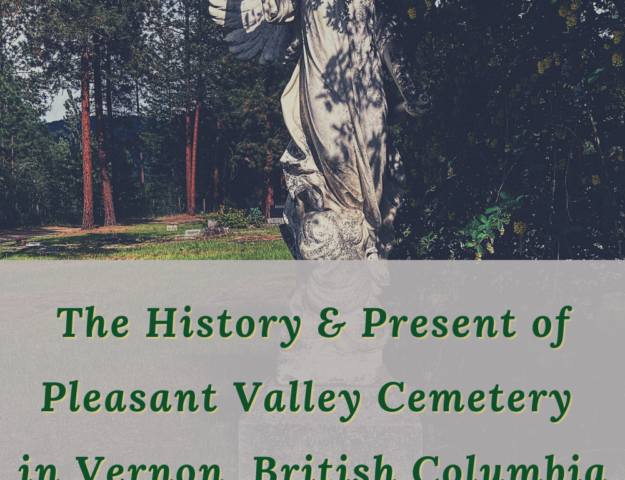
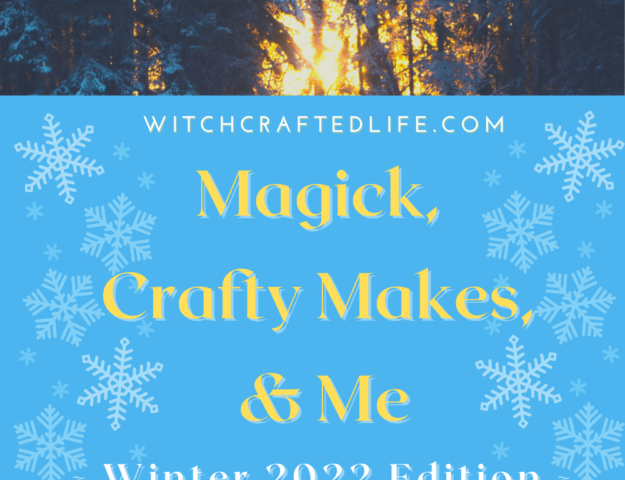

I know exactly what you mean: I enjoy visiting cemeteries and, like Tony, photographing there. So don’t take this the wrong way but your opening remarks make me think of a joke. Tony talking to someone, “My wife was blue so, to cheer her up, I took her to a cemetery.” Ha!
😄😄😄 Aww, Ally, you know just how to tickle my funny bone.
Great joke – and, come to think of it, a potentially real conversation that Tony might have with someone.
I dream of visiting the Eastern US one day and photographing some of the incredible old cemeteries that reside there. Who knows, perhaps we could all meet up at one of them someday and take a small mountain’s worth of photos in the process. 😃
Thank you very much for your wonderful comment.
🖤 Autumn
It’s always amazing to me how rick in history cemeteries can be! There are some remarkable stories behind many of them! I always love the beautiful scenery along the way including seeing the older trees…they always amaze me! A very inspiring and interesting post my friend!
That is so true, my sweet friend. Many cemeteries are a treasure trove of history – both known and, sadly, now lost to the hands of time. I adored learning more about Mt. Ida’s while researching this post and am going to make a point of asking what else the staff there might be able to tell me about it the next time we visit the museum in Salmon Arm.
Before winter set up camp again here this year, we were fortunate to be able to visit multiple cemeteries throughout the earlier fall weeks. I am pacing myself as to the rate that I post my Cemetery Journeys entries at (as there is a finite number of burial grounds in our vicinity), but will be aiming to share 2 – 4 more here, if possible, throughout 2022.
Honestly, I can hardly wait. Penning these posts (coupled, of course, with visiting the locations, taking photos of them, and then researching them further after the fact) has quickly become one of my favourite elements of running this blog.
Big hugs & many heartfelt thanks for your wonderful comment.
🖤 Autumn
Oh, Autumn, what a tonic for my soul this post was! I could almost smell the loam and the rain. Such gorgeous colours, and textures – your pictures are superb. I think you did a very tasteful job of showing your respect for the First Nations of the area. Thank you for this lovely and wonderful visit. I’ve never been to Shuswap, so I loved hearing about the history.
XO
She
Thank you wholeheartedly, my very dear friend. I truly appreciate your supportive feedback on this post and am uplifted myself to know that it helped to revive your spirits.
When I was a little girl, prior to when my folks moved us to the Okanagan (that happened back in 1993), we would usually head up to either this region and/or the Shuswap for part of each summer. Interestingly, I’ve not yet actually lived in the Shuswap though, but residing as we currently do in Armstrong gets us a mere stone’s throw away from that breathtaking lake and the region as a whole.
I suspect that you’d adore the Shuswap as well and hope that you are able to visit at some point. If possible, I’d highly suggest mid-May to mid-June or the tail end of summer. Less (as a general rule) traffic, tourists, and mosquitoes to boot, but still plenty of the beguilingly gorgeous weather and scenery that part of our province is famous for.
Scores of hugs & heartfelt thanks,
🖤 Autumn
This is a beautiful cemetery with an interesting history. Thanks for sharing.
It is my heartfelt pleasure, dear Ivana. Many thanks in turn for your supportive comment. I truly appreciate each visit and kind word that you brighten my blog with throughout the year. 💗
Delightfully, we were able to visit a few different cemeteries throughout 2021. As such, I’m hoping and planning to bring 2 – 4 new Cemetery Journey posts to WCL next year – all the while continuing to visit additional burial grounds whenever possible. 🥰
🖤 Autumn
Your writings are always interesting and so much rich history lies in those cemeteries! A wonderful post!
What a meaningful and encouraging compliment, Carol. Thank you wholeheartedly.
How right you are regarding the immense wealth of history housed in many cemeteries. They, in their own right, museums of sorts and truly stand as one of society’s most important and valuable sources of local history.
🖤 Autumn
Amazing photography and interesting history Autumn!
You are beyond kind, dear Donna. Thank you so much! I’m delighted to know that you enjoyed this history + photo filled post.
All things willing, I’m aiming to share 2 – 4 new Cemetery Journey posts in 2022 and can hardly wait to keep posting about some of the burial grounds around these Western Canadian parts. 😃
🖤 Autumn
wow fantastic post, when we visit my parents resting place, I too love to visit other plots…very interesting history here. xx
Thank you very much, sweet Annie. I am wholeheartedly sorry that your parents’ have passed. Thank you for sharing such a personal fact here with me/us.
It’s wonderful that you’re able to enjoy visiting other plots at the cemetery where they were laid to rest. I know (and sincerely understand the reasons why) doing so is often very challenging for some people. Is it an older burial ground as well?
🖤 Autumn
What a truly amazing place, thank you for all the photos and the story. I often walk through our local cemetery and admire the wonderful trees growing there and occasionally pause to look at the names and dates on the graves. They are very special places and I am so glad they bring you peace and joy xx
Thank you deeply, sweet lady. How wonderful that there’s a cemetery close enough by to where you live for you to visit it often.
The same rings true for us as well and it’s safe to say that a future edition of Cemetery Journeys will take my readers to our little town’s own history-rich (it was founded in the Edwardian era) burial ground.
I am likewise immensely glad that visiting cemeteries brings positive benefits into your life as well. I’ve long thought that far more folks could benefit from time spent in these hallowed spots and so enjoy connecting with others who are already reaping (pun not intended) the positives that can come with time spent at a cemetery.
Warm hugs for these ever chillier days of late fall,
🖤 Autumn
What a hauntingly beautiful post, Autumn. I loved reading about Salmon Arm’s history, and your graveyard photos are wonderfully atmospheric. Thank you for sharing this magical place with us! xxx
Your kindness humbles me and touches the centre of my heart, dear Ann. Thank you deeply.
I am delighted to know that you enjoyed learning about Salmon Arm. It is such a beautiful corner of the world and one that, to the best of my memory, I didn’t really get a chance to cover in any capacity on my previous blog. As I’ve been visiting that area for my entire life, I’m extra grateful to have had the opportunity to discuss it here on my current site.
Many sincere thanks again, my lovely friend. I hope that your November is going positively.
🖤 Autumn
What a fantastic post and beautiful cemetery with lots of history. The photography is gorgeous and I bet it was wonderful to visit during the fall season, it looks like a wonderful place!
Take care and enjoy your weekend.
Tammy x
You are such a radiantly kind and lovely person, Tammy. Thank you very much for your wonderful comment.
It really was a meaningful day and such a positive note to help launch the autumn of 2021 off on. Since then, we have visited some more cemeteries further afield from our town and I’ve photographed each of them. Hopefully, they will all get their own dedicated Cemetery Journeys blog posts here as time goes on (I’m aiming for 2 – 4 or so entries in this series per year).
Many heartfelt thanks again. I hope that your November is going serenely and beautifully (we have plenty of snow here now, but there are still a few tenacious signs of fall holding on for a wee bit longer).
🖤 Autumn
Your posts are so interesting and descriptive,I feel that I am there with you,viewing the beautiful autumnal colours and exploring the landscape. Seeing children’s names and ages on the headstones can only make you wonder about their lives and the diseases they were exposed to,we are so lucky nowadays. My own family research involved spending hours in the local registrars office where I was lucky enough after a few visits,to be give unlimited access to all the records.
Thank you once again for sharing.
Thank you deeply, sweet Meg. What a supportive, wonderfully kind comment.
I too am hit hard each time I see a child or very young adult’s gravemarker. They speak immediately of a life cut tragically short and a future that was not to be on this side of the veil.
Also profoundly heartbreaking is something I’ve not seen a number of times at various cemeteries over the years and that is when a young woman and an infant are buried side-by-side (or in the same coffin even, in some instances), indicating that it was the act of birth itself or complications ensuing from such that likely brought about both of their ends.
As someone who is impacted by severe infertility, these “mother and baby” gravesites seem to hit me just that much harder.
On a much more positive note, since our time spent at Mount Ida nearly two months ago now, we’ve visited a few other cemeteries further afield from our town and I’m already looking forward to hopefully dedicating a Cemetery Journeys post to each of them as time goes on (I’m aiming for 2 – 4 or so such posts here each year).
Many sincere thanks again. May you have a cozy, wonderful tail end of November.
🖤 Autumn
What a rich and storied area! Love the history and am glad to hear that the area is still continuing to thrive today. I love graveyards but the autumn foliage was my favorite part of the pics! I love in Southeast Missouri and our fall foliage is hit or miss depending on how much heat and rain we’ve had over the summer and early fall. We are getting some pretty colors right now but haven’t had that for the last few years. From someone who grew up in New York this is something I truly miss!
Thank you abundantly, my sweet friend. I’m delighted to know that you enjoyed this post. There are scarcely words enough to describe how much I enjoy every aspect of putting my Cemetery Journeys entries together. From visiting the burial grounds themselves to researching their history further, it is a meaningful and highly enjoyable process for me every step of the way.
Before Ol’ Man winter came calling earlier this month, Tony and I were able to visit a few more cemeteries (further afield from our wee town), giving me enough locations to hit my target of 2 – 4 Cemetery Journeys entries per year for 2022. Of course, time will tell if circumstances are conducive to that pace, but it’s my goal all the same (both for next year and in the years that will follow 2022). I’m sooo looking forward to shining the spotlight on each of those beautiful, history rich cemeteries as well.
I’m so sorry that fall foliage is hit or miss in your corner of Missouri. That must be frustrating for sure – especially if one is a huge fan of fall, as you are. I have never seen NY in person, let alone in the autumn, but I know that the colours there are legendary and dream of taking a trip to New York state one day during the fall.
The season was just kicking off here when I took the snaps for this post. You will it in the photos for the aforementioned additional cemeteries as well. Which, I’m not gonna lie, makes me even more excited to share those locations here, too.
You are always guaranteed a healthy dose of fall here throughout the year, so I hope that in a small way, that helps to make not experiencing the same level of autumn weather as when you lived in NY a little easier to bear. 🧡
Big hugs & the happiest of wishes for late November,
🖤 Autumn
What a great post Autumn. I am also enamored with graveyards. I actually have a page on my blog for photos of my favorite cemetery but I haven’t added much so I turned off viewing. I have never visited Mt. Ida but I did go to BC once when I lived in Seattle. This cemetery and your exploration was so vividly documented I feel like I was along the adventure with you. You write so eloquently.
My cemetery page only has pics because volumes have already been written about my favorite cemetery. I am so very lucky to live within a couple of miles, the only drawback is I can’t walk my dog there. Please enjoy a virtual visit: https://www.springgrove.org/
Blessed be,
Alicia
Thank you so very much, my lovely friend and fellow taphophile. I hugely appreciate you sharing with me about your cemetery page. I took a head-swooningly enjoyable virtual tour and had such a lovely, peaceful time doing so. Thank you deeply for giving me the opportunity to experience Spring Grove. You are so sweet!
It’s awesome as well that you had a chance to visit BC once. Whereabouts did you get to see while up this way? I’ve lived throughout various parts of the province, with the Lower Mainland and Okanagan regions being the primary spots. Beyond those, I’ve travelled extensively here in BC for much of my life and love this province beyond measure. Happily, there’s still plenty more I haven’t seen yet and tons of spots I hope to return to. Between its size and incredibly diverse landscapes + climates, it’s almost like British Columbia is a country unto itself in some respects.
If you’re ever up these Western Canadian ways again, please do not hesitate to let me know. Should you be near by, we could aim to meet up and either way, I’d be happy to share tips on what to do see and do (cemeteries visiting included) while in this neck of the woods, if you so desired.
Thank you again wholeheartedly. I’m delighted to learn that you’re huge on cemeteries as well. That is another wonderful point that we share in common. 🧡
Oodles of late fall time hugs & blessings,
🖤 Autumn
Thanks for all of the pics! I’m in love with visiting cemeteries, and I wish I could live near your area to visit the ones you’ve mentioned. As a former emo kid I visited a lot here in Madrid with my parents hahaha. My fave picture was the one from Old Section of Salmon Arm’s Mt. Ida Cemetery, the autumn color palette gives it a beautiful aura
By the way, I’ve just discovered your blog and it`s so cool, I will check your future blog posts 🙂
Kisses from https://sophisticatedmeblog.blogspot.com/
Hello dear Sofia, thank you very much for your lovely comment and for letting me know that you’re new to my blog. It’s a pleasure to connect with you and in turn to discover your own delightful site.
How wonderful that you call Madrid home. On a list of my dream travel destinations, Madrid would be up there for sure. I was actually, very briefly, in parts of Spain once more than twenty years ago now while on a trip to Portugual with some relatives. We barely crossed the Spanish border though, so I really didn’ get to see or experience the country properly. Still, I have technically stood on Spanish soil, which thinking about always makes me smile.
Have you ever been to (my country of) Canada?
I’m sure that many of the cemeteries in Spain are extraordinarily lovely and positively chock-a-block with incredible history. You can bet your last Euro that if I am ever fortunate to find my way back there, visiting as many Spanish burial grounds as I possibly can will be at the very top of my itinerary.
Many heartfelt thanks again for your comment.
Big hugs from (already very) snowy Canada,
🖤 Autumn
Autumn what beautiful photos of this cemetery. You are indeed fortunate that adoring Tony also enjoys visiting and photographing these spots of history and beauty.
I loved seeing the photo of the chiefs, as well as all the headstones and nature views that you provided. And I can see how this would be a calming visit amidst health issues and uncertain times!
Thank you deeply on every count, my treasured friend.
You are absolutely right regarding what a blessing it is that Tony understands both how important + meaningful cemeteries are to me in general, as well as what a positive impact spending time there usually has on my health and well-being. That is not something I take lightly for a moment.
I would say that for Tony, his equivalent would be time spent on or near the water (I also find such settings to be hugely relaxing and beneficial), so we really try to make a point of doing so as often as possible – especially during the warmer half of the year.
Fall is rapidly winding down here. We got at least four inches of snow on the weekend. Some of it melted in the first half of the week, but hefty-sized flakes are tumbling down as I type these words, so we’ll likely be up to the same height or more in snow in no time. Tis the season, as they say!
While I like to celebrate and honour fall straight on unto the Winter Solstice, with less than a month until Yule and precisely a month until Christmas at this point, my mind is shifting towards the coming holiday season and I’ll soon start decorating accordingly.
Post-fire, we don’t yet have a Christmas tree, but happily we do have some seasonal decor and I use the main shelf on our TV unit in lieu of a fireplace mantle, decorating it much as I would if we had one of those. I also pepper festive elements elsewhere around our wee house, including the kitchen and our bedroom.
Have you started making the season decor shift from our beloved fall to the festivities of winter as well?
Many thanks again, dear Debi. I think of you often and really hope that your November is going splendidly. 🧡
Warm hugs from ever chillier BC,
🖤 Autumn
What a beautiful and historic place. Your photos absolutely capture the history and sense of the season as well.
xoxo
-Janey
You are tremendously kind, dear Janey. Thank you very much for your wonderfully kind words.
We were very fortunate to visit multiple cemeteries within about a five-hour radius this fall (some for the first time). I took photos every step of the way and am truly looking forward to shining the spotlight on the other burial grounds we spent time at this season in future posts in this series.
As things stand now, I’m aiming for 2 – 4 Cemetery Journeys entries per year, as I feel that pace gives me a fair amount of time before I risk running out of cemeteries (in the general area) to feature. Plus, with any luck, we’ll do some travelling again in the coming years and that should help open up the cemetery sphere all the more for me/us.
Plus, technically, I have photos from various cemeteries that predate the launch of this series and I can totally dip into those, if needed/desired, too.
I really appreciate each and every one of your recent blog comments and hope that your December is off to a lovely start.
Many hugs,
🖤 Autumn
Beautiful photos Autumn, and very well researched article. It was an excellent read. I am definitely adding Mt. Ida Cemetery to my cemetery bucket list.
You are exceedingly kind, dear Chantal. Thank you so much! Should you ever find yourself out this way and like to visit (Mt. Ida Cemetry) together, please don’t hesitate to drop me a line. It would be such a pleasure to spend a lovely afternoon together at that tranquil South Shuswap burial ground.
Warm hugs for these ever chillier winter days,
🖤 Autumn